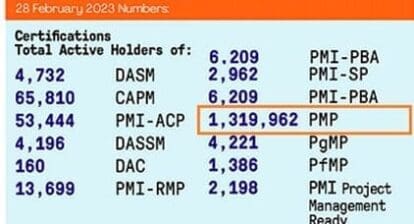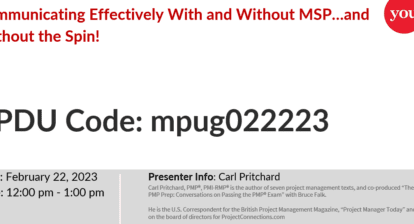First…Back to the Past
Let’s first travel back in time and look at the state of data processing and information technology (IT) historically. Knowing the past gives us a basis to move forward, and in this article, I’d like to explore what project management (PM) skills are called or in 2022 and beyond.
In the early 1960’s, most data processing (DP) systems were stand alone, non-compatible, and located only at major operating units. The applications were mostly in fields of financial reporting. Mass storage devices were widely adopted, but magnetic tape was still the primary medium for storage of data files. By the end of that decade, most systems were becoming stand-alone and compatible. Software was becoming standardized. New applications were in areas of financial control, and the use of data communications was becoming more extensive. Storage devices grew even larger, providing billions of characters of data on-line to the computer.
This era saw more extensive decentralization, and the following advantages were realized:
- Improved effectiveness
- Less severe economic consequences when failure occurred
- Less training and bureaucracy
- Less competition for service
- Less sophistication needed
In the 1970’s, we began to see a concentration of processing power at control sites with terminal access to large control databases. New applications were driven in the areas of order entry and inventory. Following are some of the advantages:
- Lower overall cost of equipment and systems
- Fewer personnel problems
- Fewer support personnel
- Better DP cost control
- More sophisticated systems
- The ability to run large jobs
By the late 1970’s, the pendulum was swinging from centralization to distributed DP (DDP)—a cross between centralization and decentralization. With DDP, computer power was decentralized at remote sites to capture and process data at its source. Transmittal of substantial amounts of clean data to a central site became the norm. Therefore, computer power was decentralized, but the control of such was still centralized.
The concept of DDP had been around a long time, but it was only possible to achieve with the development of inexpensive mini-computers and cheaper data communication devices. A real DDP system is a network of powerful, self-sufficient satellite systems communicating with each other and/or the host computer. The following are some advantages of DDP:
- Users have local processing and data storage capability
- Users have integrated access to other computers
- Users control their own data
- Non-competitive access is available
- This model reduces peak load demands on central computer power
- Greater responsiveness to user
- New applications can be quickly supported without costly additions to the central system
- Lower total system communication costs
- Less training and bureaucracy
The following are seen as disadvantages of DDP:
- Duplication of input, output, and functions
- Higher cost due to duplication of hardware, software, data, space, and people
- Some restrictions on the size and complexity of applications
- Possible incompatibilities
- More difficult management and control of operations, standards, development, and databases
- Limited vendor relations/negotiating power
As technology developed through the decades, these challenges began to be teased out. We saw broader uses of DDP elements and redistribution of previously centralized applications. We also eventually saw word processing* and DP people sharing the same workstations, the same communication systems, and the same data files. Some workstations were multi-function units with various work-keys. At a glance, work-keys were used for word processing, source data entry, central computer inquiry, or standalone DP. These multi-function units functioned in workstation clusters and communicated with other dispersed workstations clusters and/or a host computer.
Some of the shareable applications included accounts receivable, booklets, marketing surveys, mailing labels, financial reports directories, etc. Output was phototypesetting and telecommunications, for example.
Top management within each company mandated the combining of DDP and word processing for the next evolutionary jump into information processing because they realized the economics of sharing equipment, personnel, and data. The sooner advantages were adopted, the sooner a total corporate information system began to unfold.
For their projects, project managers used simple analytical tools that included progress flowcharts, decision logic tables, decision trees, Gantt charts, milestone charts, time-space networks, weighted rating, and workflow charts. These tools were easy to grasp and understand because they revolved around some form of hierarchical system.
Into the Future
As you can see, many of the trends since 1980 have evolved over the last forty years. For example, smaller/faster storage devices and increased use of micro-processors/integrated circuits, which are part of today’s IT foundation/environment. This includes the growth of the internet, cloud computing, digital media, AI applications, and Agile-based projects in this current century. Today, the world’s largest tech companies will largely decide much of what we see and hear in the future. With all this in mind, let’s consider the future of IT and project management, and, more specifically, the job skills PMs will need to evolve into the future!
Business Analytics Consultants
Business analytics (BA) depended—and still does—on getting substantial amounts of high-quality data to populate across different systems (some of the first were Oracle, IBM, and Azure databases). Deciding what subsets of data adds reporting value to the organization (a.k.a. learning “insights” from past performance, so you can do better business planning) allows PMs to be more competitive. Henry Ford used BA to help plan and build his assembly lines and many companies use it for customer loyalty programs. A current example is Microsoft’s Power BI and other similar ecosystems (Power BI Pro), all of which are really a BA service where end users can create enterprise reports, live dashboards, and rich visualizations versus depending on a IT department. Unless they are trained, most end users won’t have the expertise to work across different systems and will need an experienced Business Analytics Consultant (BAC) to help them accumulate the information or actionable intelligence they need to share and run their business most effectively. This is an area all PMs should consider in future career planning.
Strategic Project Managers
Strategic Project Managers (SPMs) or Chief Project Officers (CPOs) will soon be breaking the doors down to get into the C-suite of an organization that is driven by information and technology. These people have to know the business, be experienced in project management, be part of the portfolio decision making process, and be innovators and effective communicators. Obviously, a person in the position of SPM or CPO must be a skilled leader, highly respected, and have good relationships with stakeholders! Equally important, this person would be an influential collaborator in defining and helping to deliver the organization’s strategy.
The SPM or CPO serves as a crucial interface between the C-suite and the organization in translating the strategy and goals of a project. He/she understands the processes and advantages that need to take place to be successful. Furthermore, this person can help the organization pick the right projects.
End-to-End Project Managers
The above listed job skills demonstrate where projects transition from the PM to business owner. End-to-End PMs go to the next level and take ownership of a new product or service becoming responsible for providing its benefits. This is happening in China and slowly being embraced by Western countries. A good example of this is the Chinese company called Alibaba Group (NYSE symbol: BABA), which is one of the world’s largest e-commerce, retail, internet, AI, and technology companies. They are considered fast to market, being an Agile-project-based organization and quickly converting ideas into products and services. Their approach a much more innovative and complete way to view project management, in general. Keep in mind an end-to-end PM needs to have effective communication, possess inherent salesmanship skills, and be able to think strategically.
Fast-to-market organizations are looking for leaders that have less technical expertise and more end-to-end expertise with strong facilitation skills. These PMs usually possess a stronger business understanding with commercial insights, which should open the door for them moving up to the executive levels of their organizations. To get there, PMs need to get out of their comfort zones, adapt, and step into more leadership roles. At the same time, organizations need to become more flexible overcoming silos and traditional organizational structures, so the work done is project-based!
Summary
The role of the PM has been shifting away from someone who can tick off tasks as completed on a Gantt chart. 2022+ is bringing us more towards strategic leadership positioning for effecting change in organizations. I see a bright future for PMs and project management because there remains a strong demand for people delivering change!
IT is advancing so rapidly, with blockchain and AI, for example, that it’s beginning to outpace the public’s capacity to fully understand its ramifications. Sometimes inventing in the future can cause internal problems for large technology companies. These companies may have to reboot their own culture and/or use project process consultants to update their delivery systems and expand new product lines.
Can you foresee the day when a drone taxi will pick me up at my house? Your thoughts in the comment section below are appreciated.
*I would like to thank Mona Bertrand for her word processing insight, which was invaluable in the writing of this article.







